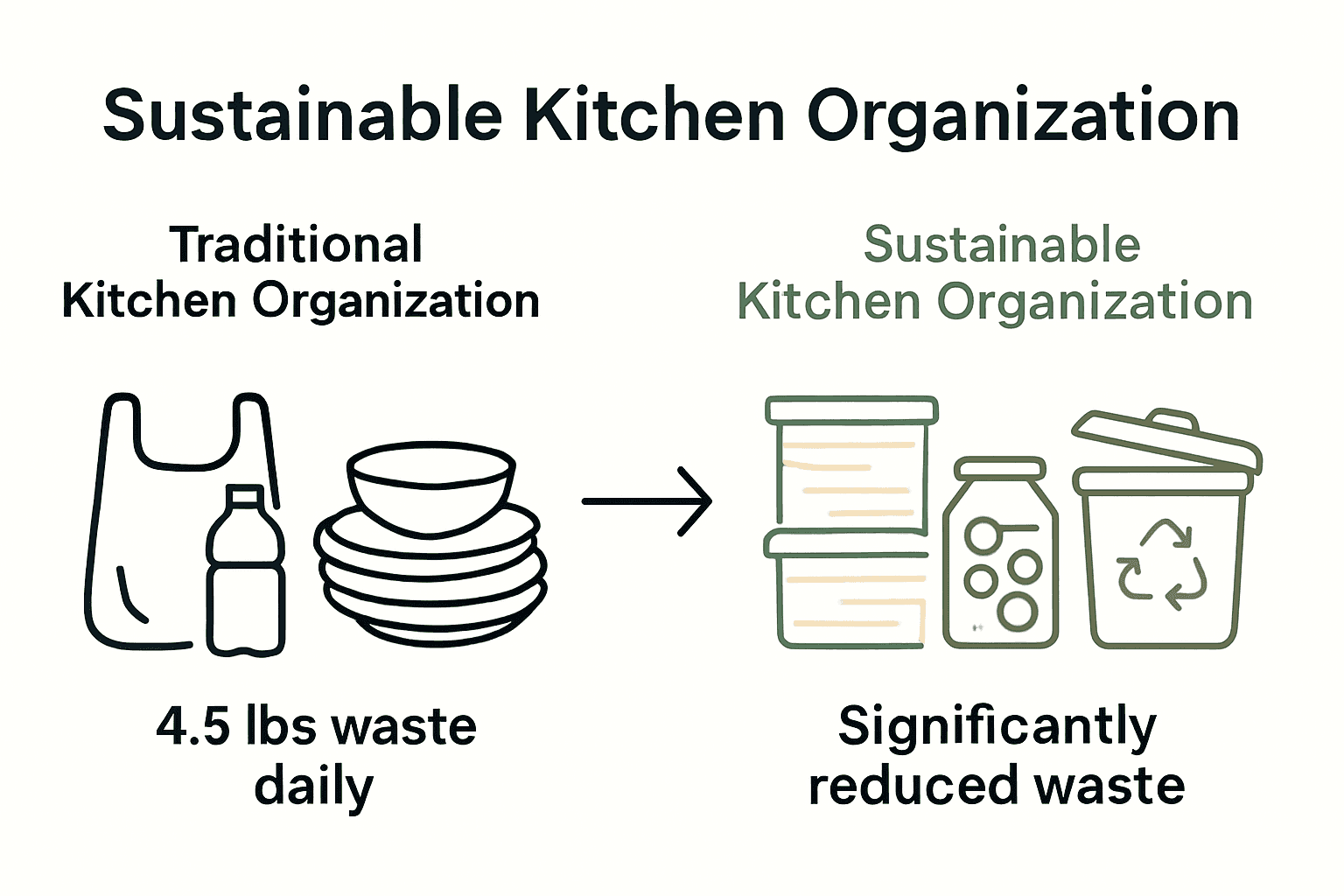Your Cart is Empty
Free Standard Shipping for Contiguous U.S. Orders!
Free Standard Shipping for Contiguous U.S. Orders!
Catalog

How to Organize Kitchen Sustainably for Lasting Impact
November 15, 2025 7 min read
Most kitchens hide an uncomfortable truth: the average home produces over 4.5 pounds of waste every day, much of it from single-use products and clutter. This steady stream of wasted resources not only harms the environment but also makes daily routines more stressful. By rethinking the way you organize and equip your kitchen, you can turn this busy space into one that is both efficient and eco-friendly. Discover clear, practical steps to create a greener, more organized kitchen that supports your values.
Table of Contents
- Step 1: Assess Current Kitchen Items For Sustainability
- Step 2: Declutter By Removing Wasteful Or Single-Use Products
- Step 3: Select Eco-Friendly Organizers And Bamboo Solutions
- Step 4: Arrange Items Efficiently For Daily Use
- Step 5: Maintain Organization With Sustainable Habits
Quick Summary
| Key Point | Explanation |
|---|---|
| 1. Assess your kitchen items’ sustainability | Review all kitchen items to identify single-use products and keep their eco impact in mind. |
| 2. Declutter unnecessary gadgets and waste | Remove items you don’t use or that generate waste to create an efficient kitchen space. |
| 3. Choose eco-friendly organizing solutions | Opt for organizers made from sustainable materials like bamboo for maximum durability and minimal impact. |
| 4. Organize based on use and task zones | Group items by frequency of use and function to streamline cooking and reduce clutter. |
| 5. Maintain organization with mindful habits | Establish consistent practices such as monthly reviews to keep your kitchen clutter-free and functional. |
Step 1: Assess current kitchen items for sustainability
Starting your sustainable kitchen journey begins with a thorough assessment of your current kitchen inventory. According to University of Michigan’s Office of Campus Sustainability, the key to transforming your kitchen lies in critically examining each item through an eco-conscious lens.
To conduct a comprehensive sustainability assessment, pull out all kitchen items and categorize them based on their environmental impact. Look for single-use products like plastic utensils, disposable containers, paper towels, and packaged goods that generate unnecessary waste. As Eugene Friends Meeting recommends, focus on identifying items that can be replaced with reusable alternatives. Create three distinct piles: keep, replace, and discard. For items in the “replace” category, seek out sustainable options made from materials like bamboo, glass, stainless steel, or recycled materials.
A practical tip is to take photos of items you plan to replace to help research eco-friendly alternatives during your next shopping trip. This methodical approach ensures you make intentional choices that reduce waste and support environmental sustainability.
 With your initial assessment complete, you are now ready to begin thoughtfully transforming your kitchen into a more sustainable space.
With your initial assessment complete, you are now ready to begin thoughtfully transforming your kitchen into a more sustainable space.
For more inspiration on sustainable living practices, check out our guide on essential sustainable living tips.
Step 2: Declutter by removing wasteful or single-use products
Decluttering your kitchen is a transformative process that goes beyond simple organization. According to Tasting Table, the key to creating an efficient kitchen space lies in systematically eliminating single-use gadgets and redundant appliances that consume valuable space and resources.
Tom’s Guide recommends a strategic approach to kitchen decluttering. Start by pulling everything out of drawers and cabinets and critically assess each item. Ask yourself key questions like: Have I used this in the past year? Does this serve a unique purpose? Can this be replaced with a more sustainable alternative? Focus on removing items such as plastic utensils, disposable containers, excessive cooking gadgets, and duplicate tools that create unnecessary waste. Create three distinct piles for your items keep, donate, and discard to ensure a systematic process.
A practical tip is to photograph items before removing them to help track your progress and remind yourself of the positive environmental impact. By intentionally reducing single-use products, you are not just organizing your kitchen but creating a more sustainable and mindful living space.
 With your decluttering complete, you are now ready to reimagine your kitchen with purpose and efficiency.
With your decluttering complete, you are now ready to reimagine your kitchen with purpose and efficiency.
To explore more sustainable home solutions, check out our guide on sustainable home products.
Step 3: Select eco-friendly organizers and bamboo solutions
Transforming your kitchen into a sustainable space requires thoughtful selection of eco-friendly organizing solutions. Sustainable Wave highlights the importance of choosing materials that minimize environmental impact while maximizing functionality in your kitchen storage strategy.
Real Homes recommends focusing on bamboo as an ideal material for kitchen organization. When selecting eco-friendly organizers, prioritize products made from renewable resources like bamboo, which offers exceptional durability and natural antimicrobial properties. Look for drawer dividers, utensil holders, cutting boards, and storage containers that are crafted from sustainably sourced bamboo. Consider factors such as size, versatility, and how each organizer can help reduce plastic waste and streamline your kitchen space.
A practical tip is to measure your kitchen drawers and cabinets before purchasing organizers to ensure a perfect fit. By investing in high quality bamboo solutions, you are not just organizing your kitchen but making a meaningful commitment to environmental sustainability. Your carefully selected eco-friendly organizers will transform your kitchen into an efficient and responsible space.
To explore more about organizing with bamboo, check out our guide to bamboo organizer options.
Step 4: Arrange items efficiently for daily use
Self Storage India emphasizes the critical importance of strategic kitchen organization that transforms your space from chaotic to functional. Efficient arrangement is not just about tidying up but creating a system that supports your daily cooking and meal preparation routines.
Ideal Home recommends organizing your kitchen by frequency of use and task zones. Group items based on their function create dedicated zones for preparation, cooking, and storage. Place frequently used tools like cutting boards, knives, and cooking utensils within easy reach. Store items close to where they will be used most often consider placing pots and pans near the stove, and coffee makers near water sources. This zonal approach ensures that everything you need is within arm’s reach and reduces unnecessary movement during cooking.
A practical tip is to use vertical space and clear containers to maximize visibility and accessibility. By investing time in thoughtful arrangement, you create a kitchen that not only looks organized but functions seamlessly with your lifestyle. Your newly arranged kitchen will feel more spacious, efficient, and tailored to your specific cooking needs.
To dive deeper into kitchen organization strategies, explore our guide on organizing kitchen drawers efficiently.
Step 5: Maintain organization with sustainable habits
Simply Well Balanced emphasizes that maintaining an organized kitchen is an ongoing process that requires consistent mindful practices. Sustainable organization is not a one time event but a continuous commitment to intentional living and conscious consumption.
Daring to Live Fully recommends developing a structured approach to maintain kitchen organization. Implement a monthly review system where you reassess your kitchen items and remove anything that no longer serves a purpose. Create simple rules for incoming items like the one in one out principle where for every new kitchen tool or gadget you bring home you must remove an existing item. This prevents unnecessary accumulation and ensures your kitchen remains clutter free and functional. Develop habits like immediate cleanup after cooking and returning items to their designated spaces immediately after use.
A practical tip is to set a quarterly reminder on your calendar for a comprehensive kitchen organization check. By dedicating just 30 minutes every three months to reassess and reorganize your kitchen space you can prevent clutter from gradually building up. Your sustainable habits will transform kitchen organization from a challenging task to an effortless and intuitive part of your daily routine.
To further explore sustainable home organization strategies, check out our bamboo home organization guide.
Elevate Your Sustainable Kitchen Organization Today
Transforming your kitchen into a sustainable space starts with thoughtful choices that reduce waste and promote eco-friendly living. The challenge many face is finding durable, stylish, and practical solutions that align with the goal of reducing single-use products and clutter while maintaining ease of use. You want organizers and storage options that support daily routines yet honor your commitment to sustainability.
Discover the power of bamboo for your kitchen storage needs with Cozee Bay’s carefully crafted Drawer Organizers | Cozee Bay® and innovative Bag Organizer with Wrap Dispenser | Cozee Bay®. These eco-friendly products not only bring natural beauty and long-lasting functionality but also make maintaining an organized and waste-conscious kitchen effortless.

Start your journey now to a more organized and sustainable kitchen with Cozee Bay’s premium bamboo solutions. Explore our full collection and experience how purposeful design can enhance your daily living. Visit Cozee Bay to find your perfect sustainable kitchen companion today.
Frequently Asked Questions
How can I assess my kitchen items for sustainability?
To assess your kitchen items for sustainability, categorize each item based on its environmental impact. Create three piles: keep, replace, and discard, focusing on eliminating single-use products and identifying sustainable alternatives.
What should I do with single-use products in my kitchen?
Remove single-use products by creating a dedicated pile for items to discard or donate. Replace these with reusable options, like stainless steel containers or bamboo utensils, to significantly reduce kitchen waste.
How do I choose eco-friendly organizers for my kitchen?
Select eco-friendly organizers made from sustainable materials like bamboo or recycled materials. Measure your kitchen drawers and cabinets to find organizers that fit perfectly and contribute to a waste-free environment.
How can I efficiently arrange items in my kitchen for daily use?
Organize your kitchen by grouping items based on their function and frequency of use. Place frequently used tools and ingredients within easy reach to streamline meal preparation and reduce clutter.
What habits can I adopt to maintain a sustainable kitchen organization?
Implement sustainable habits by routinely reviewing your kitchen items, ideally monthly, and adhering to a one-in, one-out rule for new items. Set a quarterly reminder to reassess and reorganize, keeping clutter at bay and supporting your eco-friendly goals.
How can I make my kitchen arrangement more efficient?
Maximize space by using vertical storage and clear containers, allowing for better visibility and accessibility. This helps in maintaining a functional kitchen layout tailored to your cooking habits, promoting lasting organization.
Recommended
- Cozee Bay - 7 Essential Tips for Your Kitchen Organization Checklist
- Cozee Bay - Bamboo Home Organization Guide: Stylish Eco-Friendly Solutions
- Cozee Bay - How to Organize Kitchen Drawers for Maximum Efficiency
- Cozee Bay - Understanding Why Bamboo for Kitchen Organizers Matters
- Why Sustainable Business: Complete Guide for UK Professionals - Kefihub
- 7 Key Lessons from Kitchen Extension Before and After Projects - Reltic Extend
Leave a comment
Comments will be approved before showing up.
Subscribe
Sign up to get the latest on sales, new releases and more …

